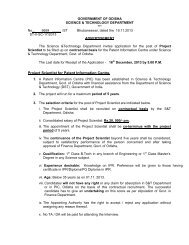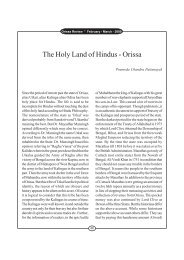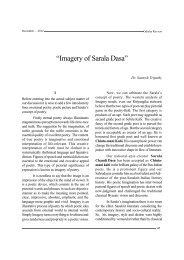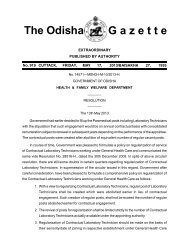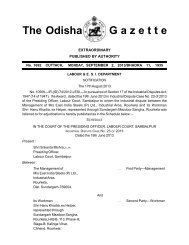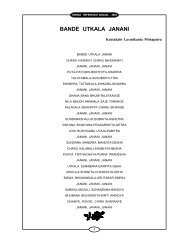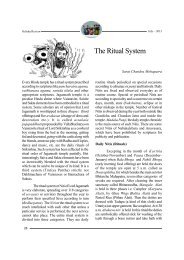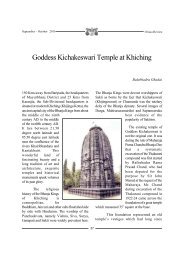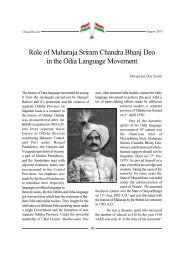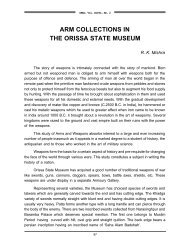Puja Rituals in Srimandir
Puja Rituals in Srimandir
Puja Rituals in Srimandir
Create successful ePaper yourself
Turn your PDF publications into a flip-book with our unique Google optimized e-Paper software.
Shri Jagannath <strong>in</strong> Yantra, Tantra and Mantra<br />
The mode of worship of Sri Jagannath is<br />
unique and different from that of the other Vishnu<br />
temples, situated <strong>in</strong> north and south India. Sri<br />
Jagannath is Pranab; He has been identified with<br />
the mystic Vedic Bijamantra 'Om'. His puja has<br />
been developed and systematized <strong>in</strong> a well<br />
designed- process by coord<strong>in</strong>at<strong>in</strong>g the basics of<br />
Vedic, Tantric and Vaisnavite streams.<br />
Dharmashastras prescribe three ma<strong>in</strong> streams for<br />
the puja of H<strong>in</strong>du Devatas, those are - Nigam,<br />
Agam and Lokacar. Nigam is the pure Vedic<br />
system, Agam is the tantric system and Lokacar<br />
is the comb<strong>in</strong>ation of both or some other system,<br />
which is followed with reference to the prevail<strong>in</strong>g<br />
conditions of the locality, time and authorities.<br />
Nigam - (the Vedic system) - The guide<br />
for Vedic Upasana (Nigam) is Karmakanda;<br />
which concentrates ma<strong>in</strong>ly on Japa, Jaga and<br />
Yagnya (fire sacrifice). - 'Swatah<br />
pramanswarup Veden nischitartho nigamyate<br />
gnayeta iti atah Vedah Nigamah, Nigamyate<br />
gnayete anena iti Nigamah.'(Devi Bhagavat -<br />
1-5-61)<br />
Agam (Tantra) - Agam or Tantra Sastra is<br />
very much elaborate and conta<strong>in</strong>s the multiple<br />
system of Upasana. The proper mean<strong>in</strong>g of the<br />
term Agam is that which has come out of the<br />
Orissa Review June - 2009<br />
<strong>Puja</strong> <strong>Rituals</strong> <strong>in</strong> <strong>Srimandir</strong><br />
15<br />
Padmanabha Mahapatra<br />
mouth of Siva; that which has entered <strong>in</strong>to the<br />
mouth of Uma; and that which is the op<strong>in</strong>ion of<br />
Vishnu. - 'Agatam Sivamukhabjat gatam tu<br />
Girija mukhe, matam ch Basudevasya tasmat<br />
Agama uchyate'. So Agam or Tantra Sastra is<br />
ma<strong>in</strong>ly based on three aspects, such as - Saivism;<br />
(Saivagam) Saktism (Saktagam) and Vaishnavism<br />
(Vaishnavagam). Agam or Tantra Sastra is a<br />
means for over all development of human society<br />
- 'Dharmarth kamamokhyadi chaturbarga<br />
sadhan pathpradarshak.'<br />
'Tantra aims to transform every action <strong>in</strong><br />
life <strong>in</strong>to a ritual, so that the <strong>in</strong>dividual performs<br />
every action and thought with a feel<strong>in</strong>g of worship<br />
and awareness. The action of bath<strong>in</strong>g, dress<strong>in</strong>g,<br />
sitt<strong>in</strong>g for worship, offer<strong>in</strong>g various symbolic<br />
sacrifices, sexual relations, stages of development<br />
from <strong>in</strong>ception to womb, birth to marriage etc.<br />
are transformed <strong>in</strong>to worship. The aim of Tantra<br />
is to unleash the cosmic energy <strong>in</strong> man, so that he<br />
rises to higher level of awareness.' ('A systematic<br />
course <strong>in</strong> ancient Tantric Techniques of Yoga and<br />
Kriya' - Swami Satyananda Saraswati-P.P. - 335<br />
/336)<br />
Tantra has been divided <strong>in</strong>to 64 parts -<br />
'Chatuhsasthi ch Tantrani'. Over and above<br />
that, sa<strong>in</strong>ts such as Kapila, Jaim<strong>in</strong>i, Basistha,<br />
Pulastya, Bhrugu, Yagnyabalkya, Sukra and<br />
Brihaspati etc. have written huge number of
Upaantras also. Tantric system has some Acaras;<br />
out of them Bamacara and Kaulacara are most<br />
important. Bamacara is not suitable for<br />
Vaishnavite system. In Tantra, Yantra and Mantra<br />
play the major role.<br />
Yantra - Yantra is the body of the deity.<br />
<strong>Puja</strong> of a deity is required to be taken up on a<br />
Yantra, so Yantra is very important.<br />
'Sarbeshameb Devanam Yantrapuja<br />
Prasashyate' (Gautami Tantra). Without a Yantra,<br />
<strong>Puja</strong> can not be taken up. If the Yantra is not<br />
known then eight-petalled lotus is to be accepted<br />
as Yantra and the puja is to be undertaken<br />
accord<strong>in</strong>gly. 'B<strong>in</strong>a Yantren chet puja Devata<br />
na prasidati, Anuktakalpe Yantram tu likhet<br />
Padmadalastakam '. (Gautami Tantra)<br />
Mantra - Mantra is the soul of the deity<br />
on a Yantra. - 'Mantrayate guptam paribhasate<br />
iti Mantrah'. Mantra is secrete, to be learnt from<br />
the best Guru. The sound of the Mantras be<strong>in</strong>g<br />
chanted comb<strong>in</strong>ed with the power of the resolve<br />
made by the person perform<strong>in</strong>g the <strong>Puja</strong>, reaches<br />
the div<strong>in</strong>e power that converts the chants <strong>in</strong>to the<br />
desired bless<strong>in</strong>gs. It is a must that Mantras are<br />
very powerful. But they must be chanted <strong>in</strong> a<br />
balanced note and rhythm. - 'Manah<br />
santoshanam saucham maunam mantrarth<br />
ch<strong>in</strong>tanam, Abyagramanirbedah japamsapatti<br />
hetabah'.<br />
Mantras <strong>in</strong> a gross level are special sound<br />
patterns. On a deeper sense they are still much<br />
more. Along with Mandalas and Yantras, Mantras<br />
are most important and considered as the essence<br />
of the practical Tantra. Mantras and Yantras<br />
(Mandalas) are utilized <strong>in</strong> conjunction with each<br />
other to form powerful comb<strong>in</strong>ation. A Mandala,<br />
Yantra or Devata is the form of consciousness.<br />
The Mandalas, Yantras or Devatas are the<br />
manifested forms, configurations of Shakti, while<br />
the Mantra, which is also Shakti, is the l<strong>in</strong>k<br />
Orissa Review June - 2009<br />
16<br />
between consciousness and form. This system<br />
applies to every th<strong>in</strong>g <strong>in</strong> the world around us. The<br />
visible form is the expression, while the Mantra is<br />
the vehicle of expression. Mantra is the direct l<strong>in</strong>k<br />
with the beyond.<br />
The deities on the Simhasana of <strong>Srimandir</strong>a<br />
have been placed on specific Yantras; Sri<br />
Balabhadra on Tara Yantra, Sri Subhadra on<br />
Bhubaneswari Yantra and Sri Jagannatha on Kali<br />
Yantra. The Daru Devatas (made of wood)<br />
themselves are Tantrics, because their<br />
construction has been made on Tantric<br />
background, with reference to Matsya Purana,<br />
Sanatkumar Samhita, Biswamitra Samhita and<br />
Hayasirsha Samhita etc., all Tantric Texts. The<br />
Vimana of Sri Mandir is a Siddha Pitha and the<br />
deities are the SiddhaYantras. To keep the<br />
Yantras; eng<strong>in</strong>es mov<strong>in</strong>g; the presence of a<br />
perfectly tra<strong>in</strong>ed and experienced Yantree or<br />
Eng<strong>in</strong>eer is always required; he is the <strong>Puja</strong>k <strong>in</strong> the<br />
literature of Sri Mandira and he is charged on<br />
Tantra. 'Mananatt Mantrah' Mantra is very<br />
difficult; it can only be learnt from perfect Gurus<br />
or teachers; and it is the only means to take up<br />
<strong>Puja</strong> <strong>in</strong> a systematic manner. Who are the Gurus<br />
then ? They are Brahma, Vishnu and Maheswar.<br />
From the above analogy we conclude that <strong>in</strong> the<br />
<strong>Puja</strong> Paddhati of <strong>Srimandir</strong>a, Guru is there <strong>in</strong> place<br />
of Mantra; <strong>Puja</strong>k is there <strong>in</strong> place of Tantra and<br />
the deities are there <strong>in</strong> place of Yantras.<br />
System of Pancaratram <strong>Puja</strong>paddhati<br />
Narada Purana mentions that the <strong>Puja</strong> of<br />
Sri Purusottama was be<strong>in</strong>g undertaken accord<strong>in</strong>g<br />
to the tenets of Pancaratra system dur<strong>in</strong>g the time<br />
of k<strong>in</strong>g Indradyumna. The same system with some<br />
additions and alterations cont<strong>in</strong>ues even at present.<br />
Among the different discipl<strong>in</strong>es of Vaishnava<br />
worship the system of Pancaratram holds a very<br />
prom<strong>in</strong>ent position. The Supreme Narayana<br />
himself, who <strong>in</strong> turn taught it to Uddhab with<strong>in</strong>
the span of five nights, directly imparted it to Sage<br />
Narad. Pancaratram literature glorifies image<br />
worship as even superior to the Vedas. Whatever<br />
that may be, under this system, the idols have been<br />
held as very necessary to conceive and meditate<br />
on God.<br />
Texts on <strong>Puja</strong>paddhati<br />
Some ritual texts exhibit<strong>in</strong>g the mode of<br />
worship of Jagannath, as available at present are<br />
mentioned below.<br />
Gajapati Purusottama Dev (1466-1497<br />
A.D), the famous Gajapati k<strong>in</strong>g of Ganga dynasty,<br />
compiled 'Gopalarchanavidhi' on the rites and<br />
rituals of Sri Jagannatha and 'Muktich<strong>in</strong>tamani' on<br />
the sanctity of Purusottama Puri. Gopalarchanavidhi<br />
otherwise known as 'Niladr<strong>in</strong>atha<br />
<strong>Puja</strong>vidhi' and 'Niladrimahodayarcanavidhi' have<br />
been compiled on the Vaishnava Skandha of<br />
Agamakalpataru.<br />
Narasimha Mishra Vajpeyee (1525-1580<br />
A.D) was the famous Smrti writer and royal<br />
preceptor of Gajapati Prataparudra Dev (1497-<br />
1533AD). Out of his 18 volum<strong>in</strong>ous works<br />
'Nityacarapradeepa' was the best and it has been<br />
published by the Asiatic Society of Bengal <strong>in</strong><br />
1928. Nityacarapradeepa has been divided <strong>in</strong>to<br />
4 parts exclud<strong>in</strong>g its Parivasa Prakaran. In this<br />
work the author described <strong>in</strong> detail, about all the<br />
temples, tirthas, lakes, Gods and Goddesses of<br />
Srikhetra. There<strong>in</strong> he has suggested for<br />
worshipp<strong>in</strong>g Sri Balabhadra <strong>in</strong> Sankarshana<br />
mantra, Sri Jagannatha <strong>in</strong> Krishna mantra and<br />
Goddess Subhadra <strong>in</strong> Devi mantra.<br />
Gadadhar Rajguru Mahapatra (1700-<br />
1750 AD) was a reputed Smrti writer, his<br />
compiled work 'Gadadharpaddhiti' has also been<br />
published by the Asiatic society <strong>in</strong> 1904 and<br />
1908. In his 'Kalasar,' <strong>in</strong> the Mangalacaran he<br />
has started with pray<strong>in</strong>g Lord Jagannath and<br />
mother Vimala. Sri Gautamiya Tantra is another<br />
Orissa Review June - 2009<br />
17<br />
work, stated to have been orig<strong>in</strong>ated at<br />
Purusottam Khetra; it has also much <strong>in</strong>fluence on<br />
the puja system of Sri Jagannath.<br />
Niladri Mahodaya is a very popular work.<br />
It states the orig<strong>in</strong>, rites and rituals of Sri<br />
Jagannath. But the period of its compilation and<br />
about it's actual author are not yet def<strong>in</strong>ite. Some<br />
say that it was compiled at the time of Ganga k<strong>in</strong>g<br />
Bhanudev IV (1414-1435 AD), but this book as<br />
a reference is not found to have been quoted by<br />
any author of Orissa till 18th century. So it comes<br />
to one's m<strong>in</strong>d that it is a later compilation. Niladri<br />
Mahodaya conta<strong>in</strong>s 91 chapters, deal<strong>in</strong>g <strong>in</strong> detail<br />
with all the rites and rituals and day-to-day<br />
functions <strong>in</strong> Jagannath temple. It is a compilation<br />
based on all Dharmasastras, Puranas and Tantras<br />
etc., hence it is called as 'Sthala Purana' <strong>in</strong> Orissa.<br />
However, the latest compilation of Niladri<br />
Mahodaya along with its Oriya translation has<br />
been edited by Dr B.K Swa<strong>in</strong> and published by<br />
Sadgrantha Niketan, Puri recently <strong>in</strong> two volumes<br />
and available <strong>in</strong> the market.<br />
Over and above all references cited above,<br />
the fairs and festivals, rites and rituals of Sri<br />
Jagannath Temple have been discussed <strong>in</strong> the<br />
follow<strong>in</strong>g works.<br />
(a) Gopalarchanapaddhati by Sri Basudev<br />
Tripathy (1700- 1750 AD).<br />
(b) Kalanirnaya - by Sri Raghunath Das (1715-<br />
1750 AD)<br />
(c) Kalsarvasva - by Sri Krishna Mishra (1750<br />
AD)<br />
(d) Virasarvasva - by Sri Gop<strong>in</strong>ath Tripathy<br />
(1778 AD)<br />
(e) Bamdev Samhita - Published by<br />
Muktimandap Pandit Sava, Puri dur<strong>in</strong>g<br />
1972.<br />
(f) Surisarvasva - by - Gov<strong>in</strong>da Kabibhusana<br />
Samantaray; edited by Sri Bhagaban Panda
and published by Orissa State Museum<br />
(published <strong>in</strong> 2 parts <strong>in</strong> 1974 and 1994)<br />
All such texts except 'Surisarvasva' have<br />
broadly dealt with the puja systems of Sri<br />
Jagannath only, but there are no ancient<br />
<strong>in</strong>dependent ritual texts exhibit<strong>in</strong>g the detailed<br />
mode of worship of Sri Balabhadra and<br />
Subhadra. Even though there are some<br />
<strong>in</strong>dependent temples of Balabhadra / Baladev <strong>in</strong><br />
some places of Orissa, which are of later orig<strong>in</strong>,<br />
the <strong>Puja</strong>ks thereof state that they follow the similar<br />
mode of worship to that of Puri temple. One small<br />
text 'Surisarvasvokta Sri Basudev <strong>Puja</strong>paddhatih'<br />
compiled by Pandit Sri Jameswara Mishra<br />
Sharma around fifty years back exhibit the puja<br />
system of only Sri Balabhadra.<br />
The Tantric texts of other states of India,<br />
which have much similarity with the puja system<br />
of Sri Jagannath, are 'Saradatilak' and<br />
'Karmadipika'. Saradatilak of Laxman Desika<br />
seems to be a composition of middle of the 10th<br />
century. The mode of worship of Srikrishna-<br />
Trailokyamohan, recommended <strong>in</strong> this work has<br />
much similarity with the worship of Purusottama<br />
Jagannath and it is compatibility to the religious<br />
notions of Orissa. 'Karmadipika' of Kesava Bhatt<br />
Kashmirika, a follower of Nimbarka School of<br />
Visnuism, is a composition of 14th century. This<br />
text is more authoritative on the worship of Gopal<br />
Krishna with the eighteen-syllabic and ten-syllabic<br />
Mantras. It does not accept Radha as the consort<br />
of Krishna but considers Rukm<strong>in</strong>i and<br />
Satyabhama as His legitimate wives. The <strong>in</strong>fluence<br />
of 'Karmadipika' on the <strong>Puja</strong> system of Jagannath<br />
is much more than any other text.<br />
In the entire Pancaratra there is only one<br />
text i.e. 'Parasara Samhita' that mentions about<br />
Sri Jagannath of Purusottam Khetra. As <strong>in</strong> the<br />
'Jagannath Khetramahatmya' of 'Skanda Puran',<br />
Orissa Review June - 2009<br />
18<br />
the Parasara Samhita quotes the <strong>in</strong>tegrated form<br />
of Lord Jagannath, Balabhadra and Subhadra. -<br />
'Jagannatheti bamangam<br />
Balaramardharup<strong>in</strong>am / Subhadrakhya-<br />
Mahalaxmi rupasardhangabesh<strong>in</strong>am // xxxx<br />
Tam paraparamabyaktam namami<br />
Purusottamam '.// Here Goddess Subhadra has<br />
been accepted as Goddess Laxmi, who blesses<br />
the world with auspicious boons.<br />
Feel<strong>in</strong>g of a common man -<br />
When a normal devotee hears the puja<br />
proceed<strong>in</strong>gs <strong>in</strong> Jagannath temple, he feels that the<br />
puja mantras are partly Vedic, partly Tantric and<br />
partly Puranic. The Vedic part is the use of 'Om',<br />
at the <strong>in</strong>itiation of the puja -mantra; the Tantric<br />
part is the use of 'Klim' for Jagannath - 'Hrim' for<br />
Subhadra, 'Slim' for Balabhadra after utterance<br />
of 'Om'. The Puranic part is - Krishna - Jagannath,<br />
Basudev - Balabhadra, Bhubaneswari -<br />
Subhadra. Sudarshan is formless, Turiya (gap<br />
between two recitation of Om), He is considered<br />
as 'Jyotibrahma'.<br />
System of worship followed at present -<br />
The seriatim of puja (<strong>Puja</strong>krama) is almost<br />
equal <strong>in</strong> respect of all the major deities placed on<br />
the Ratnasimhasan. Only we f<strong>in</strong>d variation <strong>in</strong> the<br />
Mulamantra, Devata Nyasa, Pitha Nyasa, Mantra<br />
Nyas and Murtipanjar Nyas mantras <strong>in</strong> respect of<br />
each of them, those are exhibited <strong>in</strong> the follow<strong>in</strong>g<br />
chart. As regards the Avarans (Associates) of each<br />
deity, the factual position has been expla<strong>in</strong>ed just<br />
below the chart worked out. So far as the Bhuta<br />
Suddhi, Pranab; Pran Pratistha, Martka Nyasa are<br />
concerned, the basic mantras are the guidel<strong>in</strong>es.<br />
The Upacara puja <strong>in</strong>cludes 16 Upacaras start<strong>in</strong>g<br />
from Asana to Vandana as exhibited <strong>in</strong> the<br />
succeed<strong>in</strong>g paragraphs. Dhyan mantras of all the<br />
four deities are <strong>in</strong>corporated <strong>in</strong> the last paragraph<br />
of this article.
Orissa Review June - 2009<br />
Balabhadra Subhadra Jagannath<br />
References Basudev <strong>Puja</strong> Paddhati Bhubaneswari <strong>Puja</strong> Gopalarchana <strong>Puja</strong><br />
Paddhati Paddhati<br />
Mantra Dwadasakhyar Basudev Ekakhyari Bhubaneswari Astadasakhyar<br />
Mantra Mantra Gopal Mantra<br />
'Om Namo Bhagabate "Hrim'' 'Om Klim Krishnaya<br />
Vasudevaya' Gov<strong>in</strong>daya Gopijan<br />
Ballavaya'<br />
Devata Nyasa Srikanthadi Nyasa Kala Nyasa Keshavadi Nyasa<br />
Pitha Nyasa -do - - do - - do -<br />
Mantra Nyasa Basudev Mantra Bhubaneswari Mantra Gopal Mantra<br />
Murtipanjar Nyasa - do - - do - - do -<br />
Bibhuti Panjar Nyasa<br />
As regards Sri Sudarshan there is a specific<br />
mantra, He is referred to as a thousand - spoked<br />
one Sahasrara. - 'Om Sahasrara Hum Phat'.<br />
His puja <strong>in</strong>cludes the violent aspects of Vishnu<br />
and conta<strong>in</strong> many elements of worship of<br />
Narasimha.<br />
Abaranas (Associates) of the deities - After<br />
completion of bath, offer<strong>in</strong>g of clothes, sacred<br />
threads, ornaments, flowers and sandal pastes etc.<br />
to the ma<strong>in</strong> four deities, the puja of their Abarans<br />
are to be undertaken. This is the worship of the<br />
associates of the deities, who surround them <strong>in</strong><br />
shape of a circle.<br />
Seven Abaranas of Sri Jagannath - (1) His<br />
close friends <strong>in</strong> 1st Abarana - Dama, Sudam,<br />
Vasudam and K<strong>in</strong>k<strong>in</strong>i.(2) 2nd Abarana - Hrdaya,<br />
Siras, Sikha, Kavaca and Astra portion of the<br />
Mulamantra.(3) 3rd Abarana - Eight wives of<br />
Srikrishna (4) 4th Abarana - Real and foster<br />
parents of Krishna, Balabhadra, Subhadra;<br />
cowherds and Cow - mandeis. (5) 5th Abarana<br />
- Five Kalpavrksas, celestial Vr<strong>in</strong>davana. (6) 6th<br />
Abarana - Eight Bhaktas, disciples of Krishna.<br />
(7) 7th Abarana - Digpals with their weapons,<br />
vahans (carriers) and family members.<br />
19<br />
Seven Abaranas of Sri Balabhadra -(1) 1st<br />
Abarana -Twelve syllabic mulamantra, (2) 2nd<br />
Abarana -12 Vishnus connected with 12 months<br />
- Keshav, Narayan, Madhab, Gov<strong>in</strong>d, Vishnu,<br />
Madhusudan, Tribikram, Baman, Sridhar,<br />
Hrsikesa, Padmanabha and Damodar, (3) 3rd<br />
Abarana -12 correspond<strong>in</strong>g Shaktis - Kirti, Kanti,<br />
Tusti, Pusti, Dhrti, Ksanti, Kriya, Daya, Medha,<br />
Harsa, Saraddha and Lajja, (4) 4th Abarana -<br />
four Atmas, (5) 5th Abarana - Balabhadra<br />
Himself <strong>in</strong> the middle, (6) 6th Abarana - All<br />
Digpals with their weapons (7) 7th Abarana -<br />
Ayudhas of Balabhadra.<br />
Seven Avaranas of Subhadra -(1) 1st<br />
Avarana - Monosyllabic Mantra 'Hrim', (2) 2nd<br />
Abarana - on east, south, west, north of Her-<br />
Gagan, Rakta, Karalika, Mahatsukama, (3) 3rd<br />
Abarana - on six corners of hexagon, from east<br />
clockwise- Gayatri, Savitri. Visnu, Saraswati, Siva<br />
and Brahma, (4) 4th Abarana - on 8-petals of<br />
the first lotus -Anangakusuma,<br />
Anangakusumatura, Bhubanpalika, Gaganvesika,<br />
Sasirekha, Gaganrekha, Karali and Vikarali,<br />
(5) 5th Abarana - 16 deities on 16-petalled lotus,<br />
from eastern side mov<strong>in</strong>g clockwise -Uma,
Saraswati, Sri, Durga, Jaya, Smrti, Dhrti, Medha,<br />
Mati, Kanti, Anangamadan, Anangamadanatura,<br />
Bhubanesa, Bhubanpalika, Sarvasisira and<br />
Anangavedana and 8 mothers outside the lotus,<br />
Astamatrkas, start<strong>in</strong>g from east- Brahmani (east),<br />
Maheswari (south-east), Kumari (south), Vaisnabi<br />
(south-west), Barahi (west), Indrani (north-west),<br />
Camunda (north), Laxmi (north-east), (6) 6th<br />
Abarana - 8 Digpals with their weapons, (7) 7th<br />
Abarana - Ayudhas- Sayudha and Savahan.<br />
Five Abaranas of Sri Sudarshan - (1) 1st<br />
Abarana - 4 deities <strong>in</strong> four directions - Acakra<br />
(south-east), Vicakra (south-west), Sucakra<br />
(north-west), Adhicakra (north-east). This<br />
Abarana is treated as 'Angavaran' (2) 2nd<br />
Abarana - 8 weapons hold <strong>in</strong> eight hands - Simple<br />
Namaskar Mantra 'Om Sankhaya Namah' with<br />
regards to 8 weapons hold by Him <strong>in</strong> His eight<br />
hands - Sankha, Cakra, Gada, Padma, Sara,<br />
Dhanus, Pasa and Ankusa. (3) 3rd Abarana - 8<br />
ma<strong>in</strong> Shaktis of Visnu - Laxmi, Saraswati, Rati,<br />
Priti, Kirti, Kanti, Tusti and Pusti. (4) 4th Abarana<br />
- 8 Digpals - Indra, Agni, Yama, Nirrti, Varun,<br />
Vayu, Kuber, Isana. (5) 5th Abarana - Ayudhas<br />
of the deity.<br />
Pancopacar and Shodasopacar <strong>Puja</strong><br />
By the term <strong>Puja</strong> we mean to offer some<br />
food items to God; the item due for offer<strong>in</strong>g to<br />
God is called 'Naivedya'; after the food items<br />
already offered to God it is turned to Prasad, but<br />
<strong>in</strong> the temple of Sri Jagannath it is Mahaprasad.<br />
<strong>Puja</strong> <strong>in</strong> Jagannath temple is termed as Dhoop.<br />
The literal mean<strong>in</strong>g of Dhoop is <strong>in</strong>cense. The pujas<br />
are undertaken beh<strong>in</strong>d the closed doors and the<br />
public are not allowed to see to it; when after<br />
puja; the doors are opened; the sanctum becomes<br />
smoky with descent <strong>in</strong>cense; for this reason here<br />
puja has been termed as Dhoop.<br />
In the temple of Jagannatha <strong>Puja</strong> is normally<br />
offered six times <strong>in</strong> a day. Gopal Ballav Bhoga,<br />
Orissa Review June - 2009<br />
20<br />
the morn<strong>in</strong>g breakfast at 9 AM; Bhogamandap<br />
bhoga, for public sale at 11 AM and Badasimhar<br />
bhoga, a light d<strong>in</strong>ner at 11.45 PM; are small pujas<br />
consist<strong>in</strong>g of only five Upacaras. Sakal Dhoop,<br />
the morn<strong>in</strong>g meal at 10 AM; Madhyahna Dhoop,<br />
the mid - day meal at 1PM and Sandhya Dhoop,<br />
the even<strong>in</strong>g meal at 8 PM are exhaustive pujas<br />
consist<strong>in</strong>g of sixteen Upacaras.<br />
Seriatim of rites observed dur<strong>in</strong>g <strong>Puja</strong><br />
(<strong>Puja</strong>krama)<br />
The formal rites before the <strong>in</strong>itiation of the<br />
puja on Ratna Simhasan <strong>in</strong> <strong>Srimandir</strong>, are<br />
(1) Baishnabadi Samskar i.e. fire sacrifice <strong>in</strong> the<br />
temple kitchen, (2) <strong>Puja</strong> of Surya Cakra i.e. Sun<br />
God situated <strong>in</strong> the south-east direction (agneya<br />
kona) of the temple premises and (3) <strong>Puja</strong> of Door<br />
Attendants (Dwarpals) <strong>in</strong> front of the Jay-Bijay<br />
Dwar.<br />
Three <strong>Puja</strong>pandas take up the pujas on<br />
Ratna Simhasan. The senior most <strong>Puja</strong>panda<br />
performs the worship of Sri Jagannath, so also<br />
the puja of Sudarsan, Sridevi and Bhudevi. Other<br />
two <strong>Puja</strong>pandas take up the pujas of Sri<br />
Balabhadra and Sri Subhadra respectively.<br />
Prelim<strong>in</strong>aries - The worshippers just after<br />
their arrival on the platform spr<strong>in</strong>kle some scented<br />
water on the ground and utter the Mulamantra;<br />
this is called Bhumisuddhi. They sit either <strong>in</strong><br />
Padmasana or <strong>in</strong> Svastikasana on a wooden stool,<br />
on the right side of the deities fac<strong>in</strong>g towards the<br />
images, so that they face towards the north, while<br />
the deities face towards the east. The next item is<br />
Vighnotsarana, removal of obstacles. Then they<br />
seek permission from the Bhairava. Sastras codify<br />
that Bhairava is the guardian of the Khetra so also<br />
of the temple. Next is Ghanta <strong>Puja</strong>nam - R<strong>in</strong>g<strong>in</strong>g<br />
of the hand bell -This <strong>in</strong>dicates that the puja<br />
beg<strong>in</strong>s; Ghanta also drives away all the demons<br />
from the spot. The next preparation is<br />
Pujopakarana - Drabya-Samsthapana-this is<br />
arrangement of puja articles.
Ritual purification of the self -<br />
Samanyarghya Vidhi (Preparation of holy water),<br />
Asana Suddhi (Purification of the seat), Kara<br />
Suddhi (Kara suddhi is smear<strong>in</strong>g the palms with<br />
some sandal- paste, then hav<strong>in</strong>g taken a flower,<br />
rubb<strong>in</strong>g the same with utterance of the mantra<br />
'Sudarsanaya Astraya Phat'), Dasa Diga Bandhan,<br />
Bhuta Suddhi (Purification of the elements of the<br />
body), Pranab, Prana Pratistha (Establishment of<br />
the vital breaths; Kara nyasa; Deha nyasa etc of<br />
the Mantra; meditation on Pranasakti), Pranayam<br />
(The regulation of vital breaths), Matruka Nyasa<br />
(Touch<strong>in</strong>g of various parts of the body by right<br />
hand palm and f<strong>in</strong>ger tops; along with chant<strong>in</strong>g of<br />
appropriate mantras). Antarmatruka and<br />
Bhirmatruka both to be covered.)<br />
Deification of the self - Devata Nyasa<br />
(Srikanthadi Nyasa for Balabhadra; Kala Nyasa<br />
for Subhadra, and Keshbadi Nyasa for<br />
Jagannath), Tattwa Nyasa (The worshipper has<br />
to identify the body part by part with the whole<br />
universe with all the mundane and the Dev<strong>in</strong>e on<br />
it), Bhabanacatustayam / Pitha Nyasa (Muladhar<br />
bhabana; Hrdaya bhabana; Hasta bhabana and<br />
Deha bhabana), Mantra Nyasa (Basudev mantra<br />
for Balabhadra, Bhubaneswari mantra for<br />
Subhadra and Gopal mantra for Jagannath),<br />
Murtipanjara Nyasa (Plac<strong>in</strong>g of alphabets <strong>in</strong>side<br />
and outside the body for identification with<br />
Brahma Basudev mantra for Balabhadra,<br />
Bhubaneswari mantra for Subhadra and Gopal<br />
mantra - Bibhuti Panjara Nyasa for Jagannath).<br />
Antaryaga (mental or <strong>in</strong>ternal worship) -<br />
the worshipper establishes the image of Krisna-<br />
Jagannath <strong>in</strong> his heart, undertakes an <strong>in</strong>ternal firesacrifice<br />
and offers Him mental worship. In course<br />
of conduct<strong>in</strong>g such action the Cakra <strong>in</strong> the<br />
Muladhar is considered as the Vedi and the deity<br />
is imag<strong>in</strong>ed as the fire burn<strong>in</strong>g on it.<br />
Preparation for external worship - Arghya<br />
Samskar (Vishesarghya Bidhi), Upacar Samskar<br />
Orissa Review June - 2009<br />
21<br />
(Sanctification of upacars by Bikhana; Prokhana;<br />
Tadana; Abagunthana; Dhenumudra;<br />
Mahamudra and recitation of Mulamantra),<br />
Atmapitha puja, Suddhitrayam (The purification<br />
of the worshipper; the Mantra and the Deity).<br />
Realization of the deity and Actual worship<br />
- Devata Pithapuja -Yantra puja, <strong>in</strong>vocation of<br />
the deities; Establishment of the deities; Prana<br />
Pratistha; Nyasas on the bodies of the deities;<br />
exhibit<strong>in</strong>g the Mudras of the deities; (abahan;<br />
sthapana; sanniddhana; sannirodha; sakalikarana;<br />
abagunthana; dhenumudra; amrutikaran;<br />
mahamudra; paramikarana; these are the ten<br />
mudras).<br />
Upacar <strong>Puja</strong> -(offer<strong>in</strong>g of the follow<strong>in</strong>g<br />
upacars) -- Asanam (Offer<strong>in</strong>g of seat), Swagatam-<br />
(Extend<strong>in</strong>g welcome), Padya -(Provid<strong>in</strong>g water<br />
for foot wash<strong>in</strong>g), Arghya - (Provid<strong>in</strong>g water for<br />
face wash<strong>in</strong>g), Acamaniya -(Provid<strong>in</strong>g water for<br />
mouth r<strong>in</strong>s<strong>in</strong>g), Madhuparka -(Mixture of honey<br />
and other items), Punah Acamana - (R<strong>in</strong>s<strong>in</strong>g of<br />
mouth on subsequent occasion), Snana -(Tak<strong>in</strong>g<br />
Bath on exhibition of Snana mudra), Bastra and<br />
Yajnopavita -(Offer<strong>in</strong>g of dresses and provision<br />
of sacred threads), Abarana - (Offer<strong>in</strong>g of<br />
ornaments to the deities), Gandha -(Offer<strong>in</strong>g of<br />
sandal paste and other scented materials), Puspa<br />
-(Offer<strong>in</strong>g of varieties of flowers), Puspanjali -<br />
(Offer<strong>in</strong>g of five Puspanjalis), Abarana <strong>Puja</strong> (from<br />
first Abarana to Seventh Abarana, as discussed<br />
earlier, this is an <strong>in</strong>terruption <strong>in</strong> between the<br />
Upacar <strong>Puja</strong>), Dhoop -(Offer<strong>in</strong>g of <strong>in</strong>cense),<br />
Deepa -(Show<strong>in</strong>g of candle pot to the deities),<br />
Naivedya -(Naivedya samskar; offer<strong>in</strong>g of<br />
Naivedya to the deities, show<strong>in</strong>g Naivedya mudra<br />
with mantrochattan; Japa or mutter<strong>in</strong>g of the<br />
mantra; provid<strong>in</strong>g water for ablution to the deities;<br />
acamana; offer<strong>in</strong>g of tambula and aratrikam.),<br />
Candanaivedya -(Bahyabali).<br />
Conclud<strong>in</strong>g rites - Prasannarca -<br />
(Keep<strong>in</strong>g the deities <strong>in</strong> full charm<strong>in</strong>g attitude),
Aratrikam- (This is the ma<strong>in</strong> lustration.), Bandanas<br />
- (Prayers after completion of all upcaras<br />
symboliz<strong>in</strong>g the deities as royal authorities),<br />
Brahmarpana -(Atmasamaparna before God),<br />
H<strong>in</strong>apuranam - (Mak<strong>in</strong>g good of all shortcom<strong>in</strong>gs),<br />
Nirmalya Grahanam and Prasad Sebanam etc,<br />
Pradakh<strong>in</strong>a and Namaskaram.<br />
Dhyana Mantra of Sri Balabhadra -<br />
'Om Vishnu saradacandrakotisadrusam<br />
sankhasthangam gadam, Ambhojam dadhantam<br />
sitabjanayanam kanlyajaganmohanam<br />
Abaddhangadaharkundalmahamaulisphuratkankanam<br />
Sribatsankamudarkaustubhadharam bande<br />
mun<strong>in</strong>dreih stutam'<br />
And<br />
'Shantam chandradikantam mushalahaladharam<br />
basudevagrajantam - Vogisham charubaktram<br />
bishadharmukutam sebitam devabrundeih<br />
Bandeaham lokanatham tribhubanabiditam<br />
sarbasiddhipradanam Ramamabhiram<br />
bikasitabadanam rebatiprananatham.'<br />
Dhyana Mantra of Sri Subhadra -<br />
'Yasajabakusuma patakdibyamurtim<br />
Pashankushambhayabarana nijabahudandyih.<br />
Aashodashakhyakalaya nija padmabasa<br />
Ekakhyari tribhubanadhipat<strong>in</strong>amasthe.'<br />
Dhyana Mantra of Sri Jagannath -<br />
'Phulendibaram<strong>in</strong>dukantibadanam bahambatamspriyam,<br />
Sribatsankmudarkaustubhadharam pitambaram sundaram<br />
Gop<strong>in</strong>am nayanotpalarchitatanum gogopasanghabrutam<br />
Gob<strong>in</strong>dam kalabenubadanparam dibyangbhusham bhaje.'<br />
Dhyana Mantra of Sri Sudarshan-<br />
'Sarbabyabsampurnamstabahum Sudarshanam<br />
Astayudhaparibarmastakhyarasamanwitam.<br />
Astarm chakramlyugram mushalam<br />
chankushayudham<br />
Bamtah shankhashikh<strong>in</strong>au dharayantam karambuyeih<br />
Raktachandanliptangam raktagadhanulepanam<br />
Raktabastraparidhanam raktamalabibhushitam.<br />
Agra p<strong>in</strong>galakonakhyam jwalamalatibhishanam<br />
Danstrakaralbadanam bhayasyapi bhayabaham<br />
Sudarsanabhidhanam tam cakramadhy bich<strong>in</strong>tayet.<br />
Orissa Review June - 2009<br />
22<br />
<strong>Puja</strong>ka - The Worshipper<br />
He, who offers the upacaras and naivedya<br />
to the deities, is known as <strong>Puja</strong>ka, a <strong>Puja</strong>panda,<br />
<strong>in</strong> the language of Sri Jagannath temple. As the<br />
<strong>Puja</strong>paddhati followed here is based on Vedic<br />
culture; he can also be called as an Acharya. By<br />
perform<strong>in</strong>g Asana Suddhi; Bhuta Suddhi; Kar<br />
Nyasa and Deha Nyasa of the mantra; meditation<br />
on Pranasakti; Prana pratistha; Kara Suddhi;<br />
Pranayama; Antarmatraka and Bahirmatraka<br />
Nyasas etc; the <strong>Puja</strong>k <strong>in</strong>itially attributes godly<br />
qualities <strong>in</strong> himself and then undertakes the puja<br />
of the deities.<br />
An Acharya must have been born <strong>in</strong> a high<br />
family, he must have acquired thorough<br />
knowledge <strong>in</strong> Vedas; Upanishads; Vedangas;<br />
Smrutis; Agamas and specifically on the<br />
Pancaratra puja system. He must be a man with<br />
full faith and devotion to God and well-versed on<br />
Vedic as well as Tantric mantras. He should be a<br />
married person; ma<strong>in</strong>ta<strong>in</strong> perfect health and there<br />
may not be any physical deformities <strong>in</strong> him. He<br />
must be perform<strong>in</strong>g his daily rout<strong>in</strong>e works; snana;<br />
suddha bastra paridhan; bandana; tarpana;<br />
baiswadeva; sandhya and gayatri etc. with all<br />
devotions and then proceed to the temple premises<br />
for Devarchana. In the Niladri Mahodaya,<br />
Chapter 38 to 89 specifies the daily rituals to be<br />
undertaken by a <strong>Puja</strong>ka before proceed<strong>in</strong>g to take<br />
up the puja of Sri Jagannath. He is to be<br />
compassionate; pious; righteous; peaceful; truthful<br />
and helpful. He has to ma<strong>in</strong>ta<strong>in</strong> a pure and simple<br />
life style without <strong>in</strong>volv<strong>in</strong>g himself <strong>in</strong> any unethical<br />
matters and observe a spiritual code of conduct<br />
<strong>in</strong> his personal private life. So he is the <strong>Puja</strong>ka of<br />
Sri Jagannath and to be respected by one and all.<br />
Padmanabha Mahapatra is the Sri Mandira Purohit. He<br />
lives <strong>in</strong> Pratihari Lane, Matimandap Sahi, Puri.



